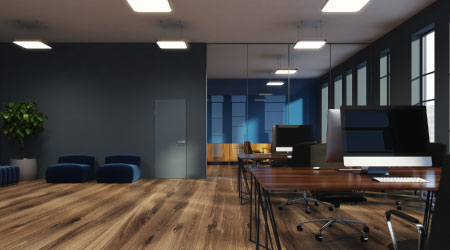Green Flooring Choices: What's Old is New
Go back 20 years and flooring choices were pretty cut-and-dry. An office space meant carpet, and carpet meant broadloom. For resilient flooring — the hands-down choice in schools and hospitals — the choice was usually between two types of vinyl: sheet vinyl or, for tighter budgets, vinyl composition tile (VCT).
All that has long since changed. While broadloom carpet and vinyl flooring are still very widely used, they are no longer the default choices they once were. A plethora of new products has come onto the market. And products that have been around a long time are being used in spaces where they likely would not have been used in the past.
Lately, the goal of being sustainable is remaking the way facility executives, manufacturers and designers think about flooring. “LEED has been the single biggest impetus for change in the specification and manufacturing of flooring materials over the past decade,” says Liz Bray, an associate of Yost Grube Hall. She says she has seen growing use of rubber and linoleum as flooring materials.
But LEED has not operated in a vacuum. As facility executives have raised the demand for green products, manufacturers have responded, so that sustainable products are more readily available today than in the past. Recyclable carpet backing, for example, is much more readily available than it was 10 years ago. And today there are flooring products with recycled content or ones that use bio-based materials instead of petroleum.
One impact of the move to sustainability has been a resurgence of interest in products that have been around for a long time. Linoleum is one example. As with other “old school” products, it has benefited from technological advancements that have improved performance.
Cork flooring is another example. Used successfully in federal buildings 80 or 100 years ago, it is now coming back into vogue, says Grzegorz Kosmal, design director of interiors at Perkins & Will. Cork flooring is made out of ground cork to which heavy pressure is applied. The cork is then bound in its own natural resins.
Wood flooring is also becoming more popular, although wood is a green solution only if the material is harvested and manufactured in a sustainable manner, from the tree farmer to the final installer. “In Europe, wood is a little more popular, but in the U.S. it is catching on,” Kosmal says.
Changes in technology have improved the performance of wood floors, says Jim Gould, president of the Floor Covering Institute, an international consultancy group. In the past, wood floors had to be sanded, stained and sealed, but now urethane coatings on wood floors require that they simply be wiped clean with water or water and vinegar. In addition, wood floors had to be nailed down in the past, but now they are engineered to be dimensionally stable when put in place and do not require fastening.
Terrazzo, another older solution, is also making a comeback, says Kosmal. The Reagan International Airport uses terrazzo, a substance with a lot of flexibility in color and texture. According to Kosmal, a generation of artisans that could put down terrazzo has been lost. Still, it is an inexpensive and green solution for institutional use, and in Washington, D.C., there are still shops that can make terrazzo.
None of this is to say that widely used products like carpet are on the way out. “We are using many more choices in sustainable and Green Labeled carpet,” says Kosmal. “Carpet is a fantastic medium.”
Carpet manufacturers have taken steps to reduce the environmental impact of carpet. Carpet reclamation programs will take back old carpet and recycle it into products ranging from carpet to auto parts. Carpet is available with various levels of pre- and post-consumer recycled content. And carpet that uses bio-based materials is also available. In some cases, used carpet can be cleaned and reused. Manufacturers have taken steps to reduce the energy and water used in the carpet manufacturing process.
What’s more, carpet quality has also improved, says Nancy Schmidt, head of the interior architecture department of the Rochester, Minn., office of HGA. The biggest change has been in backings that do not unravel and that eliminate the need for chair pads. “Carpets come with de-lamination warranties and edge ravel warranties, which allow designers to cut more freely to create accents, curved borders, patterns and interest,” she says.
Complex Choices
When it comes to being a good planetary citizen, it is important to understand that sustainability is a complex issue. People are often fooled by something that may seem to be green on the surface, but “you have to really dig down to find out if a product is green — you have to study the whole life cycle of a product,” Gould says. For example, a bamboo floor, made out of material that regenerates every six or seven years, might sound like an ideal sustainable product, but that’s before one considers what it costs environmentally to steam it, make it into a floor and then ship it around the world.
While Gould praises the LEED standards, he also says, “I wouldn’t use those standards as a bible — they are a guide.” He advises facility executives to cultivate people in the industry whom they trust and who have a clear understanding of the many facets of sustainability. It is also important to do their own research to get a better understanding of safety and environmental concerns that may affect their choice of floorcovering.
For facility executives trying to evaluate the green claims of flooring manufacturers, third-party certification bodies are valuable resources. Because green claims have proliferated, it can be difficult to distinguish legitimate claims from greenwash. Third-party certification bodies validate specific green characteristics of products.
Despite the complexity involved in selecting greener flooring products, experts say that sustainability will only become more important in the future. “LEED today is what ADA was 10 or 15 years ago,” says Richard Smith, principal in the Denver office of IA Interior Architects. When it first came out, ADA sometimes presented a design challenge. Nowadays, people naturally design to ADA specifications. Although ADA is mandatory and LEED is voluntary, Smith sees the same thing happening with LEED. “The LEED standard will become something that people do not need to ask for, but rather a normal part of the design process.”
Related Topics:














